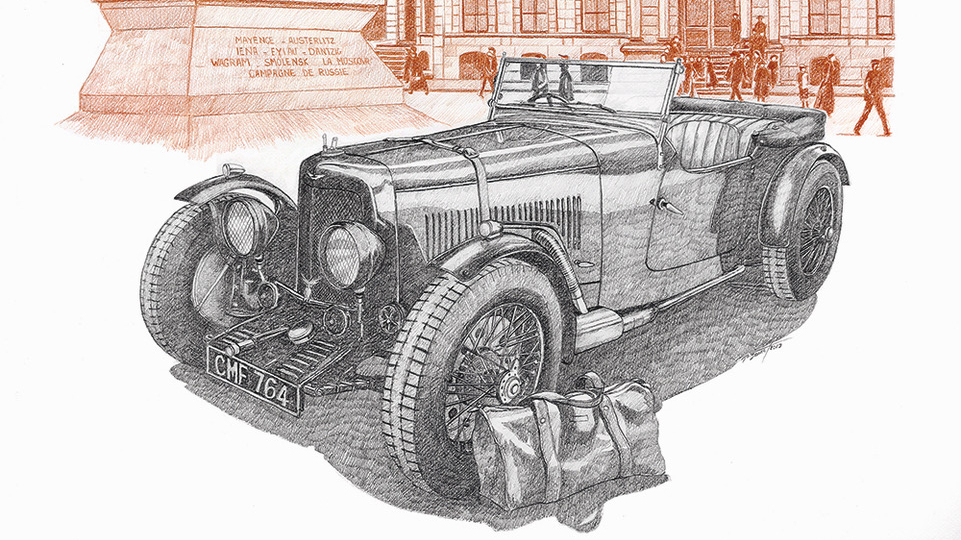
Patrick Brunet est un dessinateur de l’automobile renommé originaire, comme le rallye, de l’incontournable commune de La Bazouge du Désert, à une dizaine de kilomètres de Fougères (Ille & Vilaine). Son travail est présenté sur son site internet http://www.patrick-brunet.com, que l’on vous recommande d’aller visiter. Patrick a co-fondé l’association du rallye de Fougères et sa contribution est chaque année hautement appréciée : il dessine l’affiche du rallye, généralement composée d’un auto de la marque d’honneur, inséré dans un site ou près d’un monument révélateur de la ville hôte du rallye. Voyons quelques exemples, en commençant par les affiches les plus récentes…

2020 : ce dessin est présenté plus en détail dans un article précédent. Sans rallye « réel » cette année-là, il constituera l’affiche de 2021, qui accueillera toujours les Talbot et autres marques du group STD comme invitées d’honneur. L’auto est une Talbot 14LS de 1956 et la partie sanguine est constituée du fameux viaduc ferré de Morlaix et de l’église Saint-Melaine de la même ville (XV et XVIème siècles).

2019 : l’APPF avait tenu à inviter une marque prestigieuse pour le vingt-cinquième rallye et ce sera Aston-Martin. L’auto choisie par l’artiste est le plus souvent l’une des autos inscrites et son choix s’arrêta sur un modèle Ulster de 1935, en provenance de la région Parisienne. Le rallye reste sur Fougères et la toile de fond est partagée entre la statue équestre du Général Jean Ambroise Baston de Lariboisière et l’étonnante usine Cordier.
Le général était né à Fougères en 1759 et il mourut pendant la campagne Napoléonienne de Russie, en 1812. Inscrit sur l’Arc de Triomphe à Paris, son nom fut donné au grand hôpital proche de la Gare du Nord que connaissent bien les Franciliens. La statue originale, oeuvre de Récipion, a été saisie et fondue par les Allemands en 1942. Elle fut remplacée à l’identique en 1999, place Lariboisière à Fougères.
L’usine Cordier, d’un grand luxe architectural, fabriquait… des chaussures, à la grande époque industrielle de Fougères : jusqu’à 12.000 ouvriers étaient employés dans ce secteur au début du XXème siècle et les nombreuses usines assuraient à la ville un leadership national incontesté. La bâtiment n’a pas résisté aux bombardements et un immeuble d’habitation de l’immédiat après-guerre fait aujourd’hui face à la statue du Général, place Lariboisière.

2018 : la 24ème édition du rallye fait étape à Granville et une visite à la Villa Les Rhumbs s’impose, surtout avec une marque aussi aristocratique que Bristol comme invitée d’honneur. L’élégante propriété sera le cadre de l’enfance du grand couturier Christian Dior, né à Granville un an avant l’achat, en 1906, de cette superbe demeure par ses parents. Les jardins à flanc de falaise et les vues spectaculaires sur la Manche complètent la visite du musée Christian Dior installé dans la Villa.
32 Bristol s’inscrivirent au rallye, un chiffre peut-être jamais atteint par une autre manifestation hors du Royaume-Uni. Patrick Brunet apprécia le coupé 404, un coach fabriqué en très petite série de 1953 à 1955 et il en fit son modèle.
_____________________________________________________________________
The rally history through the posters of Patrick Brunet. Part 1.
Patrick Brunet is a renowned artist. Like the rally, he was born in the village of La Bazouge du Désert, near Fougères in Brittany. You can see his work on http://www.patrick-brunet.com. Patrick co-founded the Fougères Rally and, each year, he designs the rally poster, generally consisting of a car (marque of honour) with an historic background characteristic of the host city. Let’s see some examples, starting with the most recent posters …
2020: this drawing is presented in more detail in a previous article. Without a « real » rally that year, it will constitute the poster for 2021, which will welcome the Talbot and other makes from the STD group as marques of honour. The car on the poster is a 1956 Talbot 14LS and the setting shows the famous railroad viaduct of Morlaix and the Saint-Melaine church (15th and 16th centuries).
2019: the APPF wanted to invite a prestigious brand for the twenty-fifth edition and Aston-Martin fitted the bill. The car chosen by the artist, generally a car that takes part in the event, is a 1935 Ulster model, coming from the Paris aera. That year, the rally stayed around Fougères and the backdrop is shared between the equestrian statue of general Lariboisière and the amazing Cordier factory.
The general was born in Fougères in 1759 and died in 1812 during the Napoleonic campaign in Russia. Carved on the Arc de Triomphe in Paris, his name was given to the large hospital near the Paris Gare du Nord well-known to the people of Ile-de-France. The original statue, the work of Récipion, was seized and melted by the Germans in 1942. It was replaced identically in 1999, place Lariboisière in Fougères.
The Cordier factory, of great architectural luxury, manufactured … shoes, in the great industrial days of Fougères: up to 12,000 workers were employed in this sector at the beginning of the XXth century and the numerous factories ensured the city’s undisputed national leadership. The building did not survived WWII bombings and a post-war apartment building now faces the general’s statue, place Lariboisière.
2018: the 24th edition of the rally stopped in Granville, Manche, and a visit to the Villa Les Rhumbs was an obvious choice, especially with a marque of honour as aristocratic as Bristol. It is in this elegant house that the great fashion designer Christian Dior spent his childhood. He was born in Granville a year before the purchase, in 1906, of this superb residence by his parents. The cliff-side gardens and spectacular views of the English Channel complete the highly recommended visit of the Christian Dior museum, inside the Villa.
Thirty two Bristol cars entered the rally, a figure probably never reached by another event outside the United Kingdom. Patrick Brunet chose to draw one of the participating 404 coupés, a model made in very small numbers, from 1953 to 1955.


